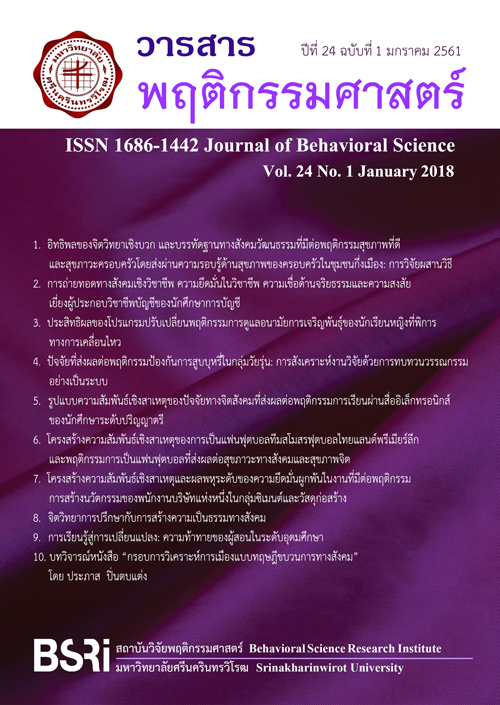โครงสร้างความสัมพันธ์เชิงสาเหตุและผลพหุระดับของความยึดมั่นผูกพันในงานที่มีต่อพฤติกรรม การสร้างนวัตกรรมของพนักงานบริษัทแห่งหนึ่งในกลุ่มซิเมนต์และวัสดุก่อสร้าง
Keywords:
แบบจำลองสมการโครงสร้าง พหุระดับ, พฤติกรรมการสร้างนวัตกรรม, ความยึดมั่นผูกพันในงาน, multilevel structural equation modeling, innovative work behavior, work engagementAbstract
งานวิจัยนี้มีวัตถุประสงค์เพื่อพัฒนาและทดสอบแบบจำลองโครงสร้างความสัมพันธ์เชิงสาเหตุพหุระดับของความยึดมั่นผูกพันในงานที่มีต่อพฤติกรรมการสร้างนวัตกรรมของพนักงานบริษัทแห่งหนึ่งในกลุ่มผลิตซิเมนต์และวัสดุก่อสร้าง กลุ่มตัวอย่างคือพนักงานในบริษัทแห่งหนึ่งของกลุ่มซิเมนต์และวัสดุก่อสร้าง จำนวน 62 ทีม สมาชิกรวม 398 คน ซึ่งได้มาจากการสุ่มแบบแบ่งชั้นภูมิ เครื่องมือวัดในการวิจัยคือแบบสอบถามโดยพนักงานเป็นผู้ประเมิน ซึ่งผ่านเกณฑ์การตรวจสอบความเที่ยงตรงเชิงโครงสร้างโดยการวิเคราะห์องค์ประกอบเชิงยืนยัน วิเคราะห์ความเชื่อมั่นโดยใช้ค่าความเชื่อมั่นในการวัดตัวแปรแฝง และผ่านการตรวจสอบคุณภาพการวัดตัวแปรระดับทีมด้วยการตรวจสอบองค์ประกอบเชิงยืนยันแบบพหุระดับ ตรวจสอบความสอดคล้องและความเชื่อมั่นสำหรับคะแนนของสมาชิก และทดสอบโครงสร้างความสัมพันธ์ด้วยการวิเคราะห์แบบจำลองสมการโครงสร้างพหุระดับ ผลการวิจัยพบว่า แบบจำลองโครงสร้างความสัมพันธ์เชิงสาเหตุพหุระดับของความยึดมั่นผูกพันในงานที่มีต่อพฤติกรรมการสร้างนวัตกรรมหลังการปรับ มีความกลมกลืนกับข้อมูลเชิงประจักษ์เป็นอย่างดี (χ2=107.316, dƒ=69, p value=0.0022, CFI=0.976, TLI=0.960, RMSEA=0.037, SRMRW=0.034, SRMRB=0.071) ทั้งนี้ความยึดมั่นผูกพันในงานเป็นตัวแปรคั่นกลางที่สำคัญที่สุดทั้งในระดับบุคคลและระดับทีม ในด้านตัวแปรเชิงสาเหตุ ภาวะผู้นำที่แท้จริงเป็นตัวแปรที่มีค่าอิทธิพลรวมสูงที่สุดและมีอิทธิพลข้ามระดับต่อความยึดมั่นผูกพันในงานและพฤติกรรมการสร้างนวัตกรรม ข้อค้นพบที่น่าสนใจคือการใช้วิธีการวัดตัวแปรกลุ่มตามแบบจำลองที่แตกต่างกันทำให้ค่าอิทธิพลของความยึดมั่นผูกพันในงานที่ส่งผลต่อพฤติกรรมการสร้างนวัตกรรมในระดับทีมมีความแตกต่างกัน
Multilevel Structural Equation Modeling of Causal Variables and Their Influence on Work Engagement in Innovative Work Behavior among Employees of a Cement and Construction Materials Company
The purpose of this research was to develop and to test the multilevel causal model and the effects of work engagement on innovative work behavior of employees in a cement and construction materials company. The sample of the research consisted of three hundred and ninety eight employees from sixty two innovation teams. The questionnaire was used for data collection. Confirmatory Factor Analysis was applied to assess the construct validity all of the variables of the measurement model. In term of the data analysis processes, Multilevel Confirmatory Factor Analysis, interrater agreement and interrater reliability were applied to assess the construct validation of the team level variables, while Multilevel Structural Equation Modeling was applied to test the multilevel causal model and the effects of work engagement on innovative work behavior of employees. The modified causal and effects model showed a good fit (χ2= 107.316, dƒ= 69, p = 0.0022, CFI= 0.976, TLI = 0.960, RMSEA= 0.037, SRMRW = 0.034, SRMRB = 0.071). However, work engagement was the central variable of the model. This was showed by work engagement were the complete mediators at both the individual and team level. Authentic leadership had the highest total effect on team efficacy and team innovative work behavior. Besides, authentic leadership had a cross-level effect on work engagement and innovative work behavior. The most interesting findings of this research were the effect of work engagement by the different composition model of work engagement on innovative work behavior.
Downloads
Downloads
Published
How to Cite
Issue
Section
License
Behavioral Science Research Institute, SWU
114 Sukhumvit 23, Bangkok 10110, Thailand.
Tel.02-649-5000 # 17600



